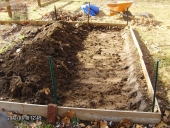The good news is that things look better this year than they have in the past.
That's a sure sign that you're doing the right things. Usually what happens is once you start to see improvement, the rate of improvement increases. Next year will be better, and the following year even better. Each plant has its own needs regarding sun, water, soil pH, and soil fertility, and some do better with certain companion plants. Some plants actually prefer infertile soil. It's so much easier now than when I started gardening 40 years ago, because you can find out exactly what any plant needs for free on the internet.
Because you have clay not far down, you may need to either build raised beds, hugelkultur beds, double dig, or just be patient and let earthworms work your mulch down into the clay. The problem with shallow clay is it can cause soggy roots, and most plants cannot take soggy roots, aka wet feet.
Some plants like wet feet, such as canna lily, for example. One key point in permaculture is to try to grow plants that like the conditions that you happen to have at your location. The more you can do that, the less you have to modify your conditions.
We're all guilty of not being patient enough when it comes to gardening. I catch myself doing it all the time. That's one of the things you will learn as you gain more experience. I'm still learning it. Keep up the good work!



